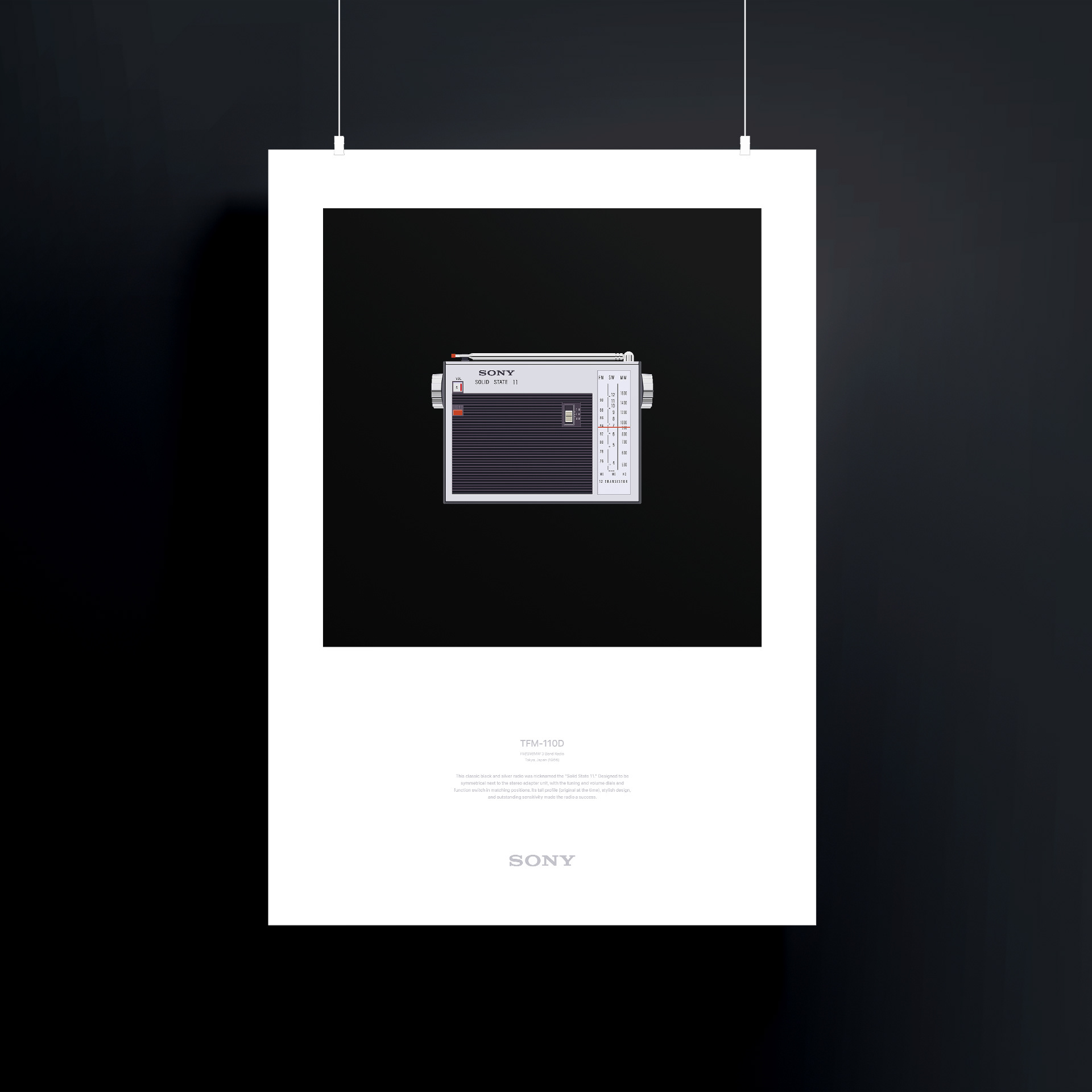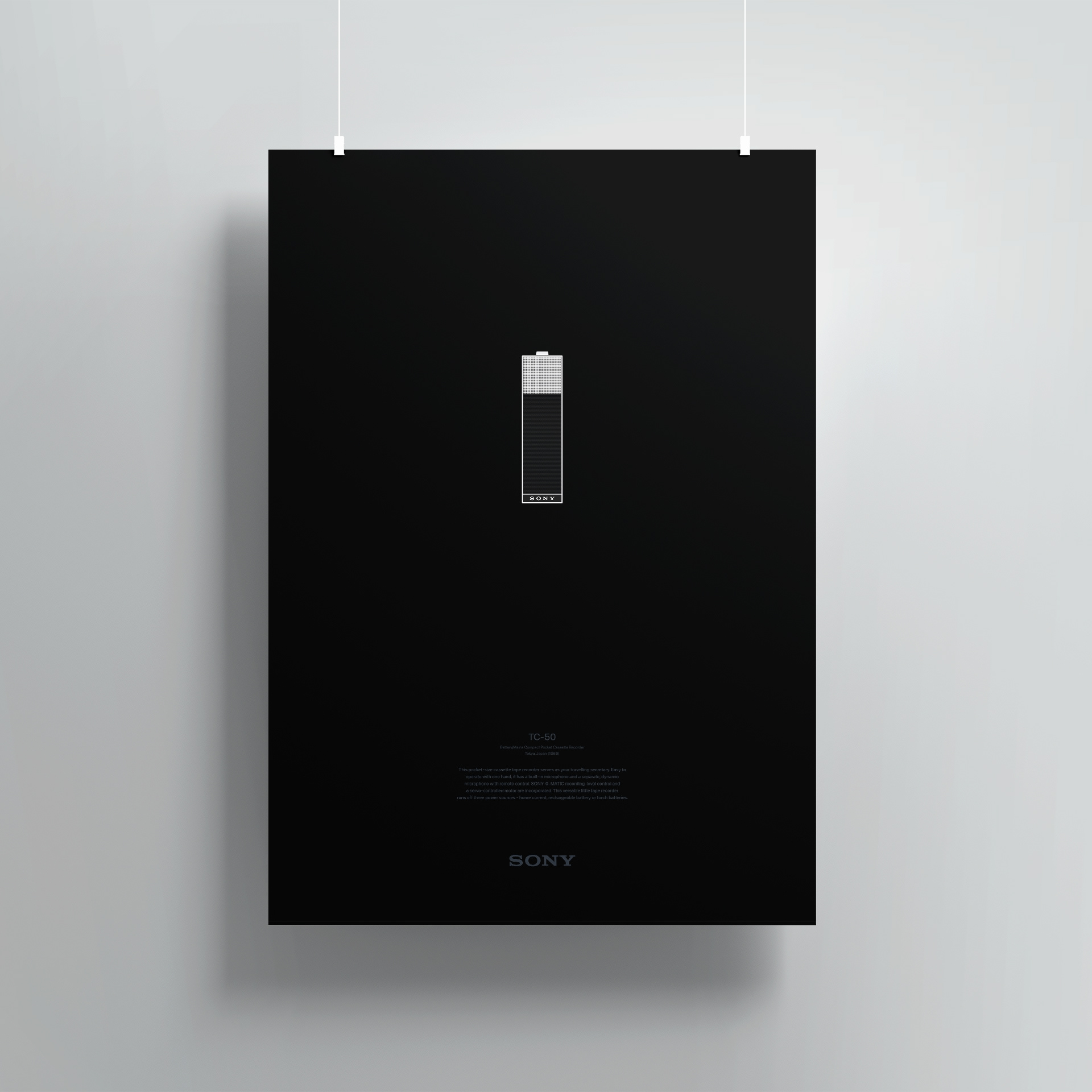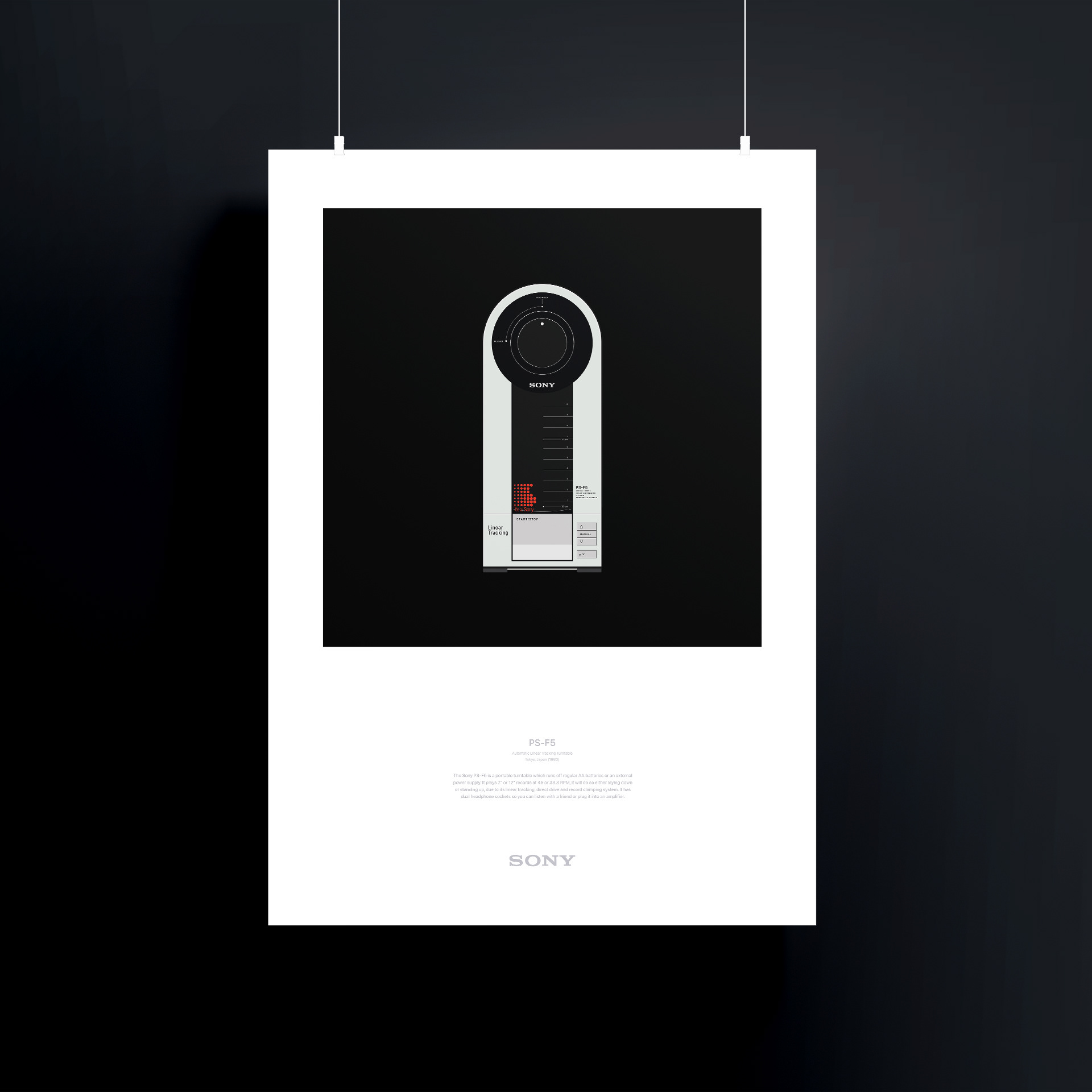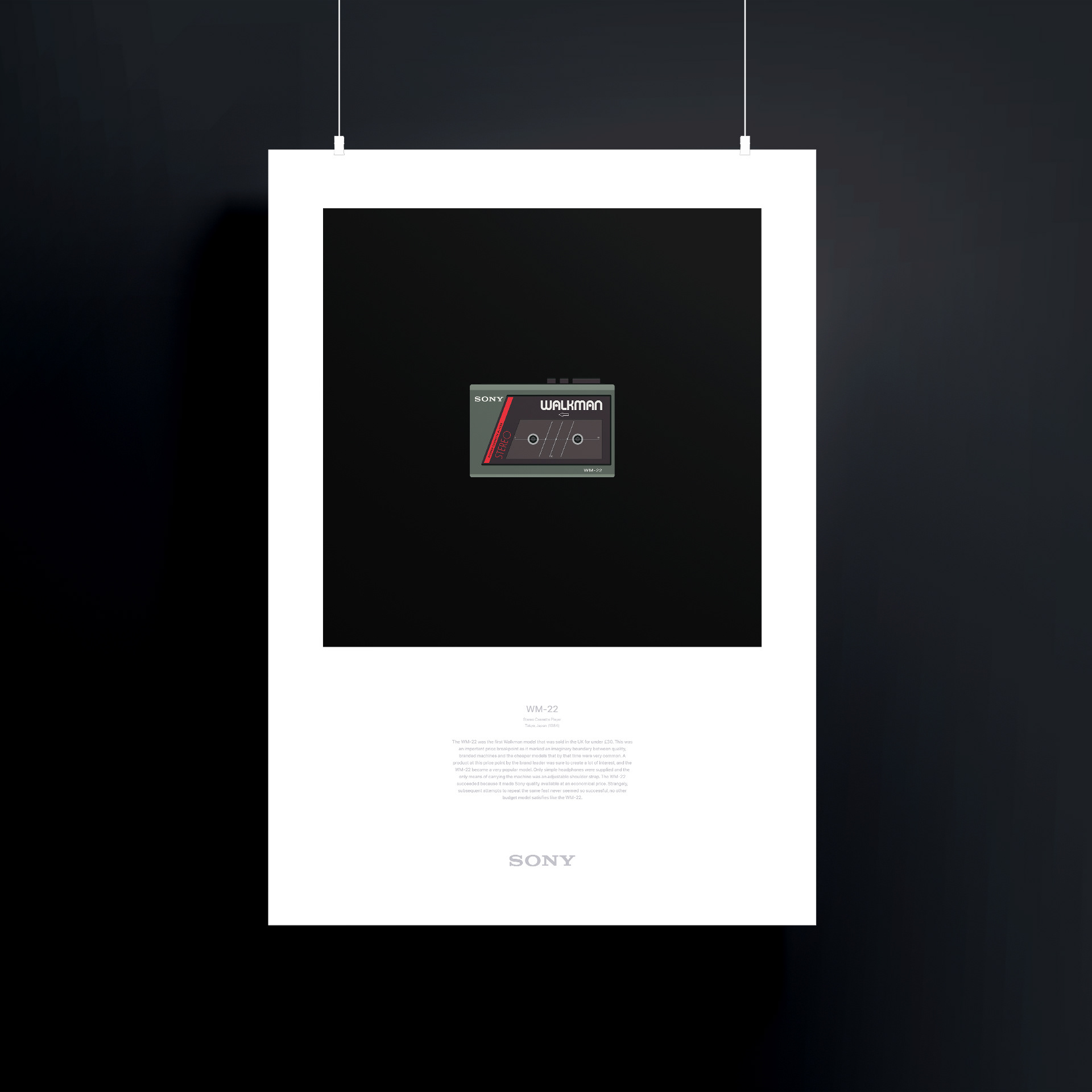Sony Design
Product Design Illustration.
Since 1961, Sony has shape the world of today by placing design at its heart.
Since 1961, Sony has shaped the world of today by placing design at its heart. Founding a Sony dedicated Design Center in Tokyo (1961) and the Design Center Europe (1980) after that was the first of its kind in Europe. Sony has always been at the forefront of design by keeping true to the founders’ doctrine of “Do what has never been done before” and “Always stay one step ahead.” Since its inception, Sony Design has faithfully adhered to these wise words, forging its reputation as a leading, award winning design team. Guided by five core principles, Curiosity, Empathy, Integrity, Ambition and Visionary. Using these principles, Sony has sought to develop innovative products that not only deliver high performance, but are also simple to use and beautiful to experience.
This is a personal project which archives the most revolutionary and iconic Sony designs through illustrations. This project is born from my love of industrial design and my admiration for Sony's design history. This project is composed of 24 illustrations showing design achievements and commercial innovations at its time. The 24 pieces have been illustrated from a 2 dimensional point of view, focusing on shape and colours in their simplest form.
Limited edition prints are available on my Etsy store TheRetroPrintsArt. Each piece is limited to 100 prints. Printed on the delicate 290gsm Hahnemühle Bamboo Matt Smooth. Every print comes numbered and certified.
Sony TFM-110D
FM/SW/MW 3 Band Radio
Tokyo, Japan (1966)
FM/SW/MW 3 Band Radio
Tokyo, Japan (1966)
This classic black and silver radio was nicknamed the "Solid State 11". Designed to be symmetrical next to the stereo adapter unit, with the tuning and volume dials and function switch in matching positions. Its tall profile (original at the time), stylish design, and outstanding sensitivity made the radio a success.


Sony TC-50
Battery/Mains Compact Pocket Cassette Recorder
Tokyo, Japan (1969)
Battery/Mains Compact Pocket Cassette Recorder
Tokyo, Japan (1969)
This pocket-size cassette tape recorder serves as your travelling secretary. Easy to operate with one hand, it has a built-in microphone and a separate, dynamic microphone with remote control. SONY-0-MATIC recording-level control and a servo-controlled motor are incorporated. This versatile little tape recorder runs off three power sources - home current, rechargeable battery or torch batteries.


Sony TC-110
Portable Cassette Deck
Tokyo, Japan (1970)
Portable Cassette Deck
Tokyo, Japan (1970)
The replacement model for the TC-100 looked very similar but had been updated and improved in just about every possible way. the first step on the path that would eventually lead to the Walkman® a decade later. Sony’s choice to adopt the Philips Compact Cassette format rather than developing an incompatible one of their own did much to popularise tape recording, which became an attractive and viable domestic activity with the establishment of the cassette as the single worldwide standard.


Sony ST-70 & Sony TA-70
AM/FM Stereo Tuner
Tokyo, Japan (1972)
AM/FM Stereo Tuner
Tokyo, Japan (1972)
Hi-fi system incorporating facilities normally found in higher models. These include MPX decoder for FM stereo, AFC switch, tuning meter, stereo indicator light, built-in AM/FM aerials and external antenna terminals for AM/FM. It has been designed with all the experience that has made Sony world-famous for quality in hi-fi. Features include, selector for a magnetic or ceramic cartridge, tape/source monitor switch, headphone jack, DIN connector socket, high filter switch and facilities for SQ quadraphonic sound by connecting model SQA-200 decoder amplifier.


Sony TC-40
Cassette-Corder
Tokyo, Japan (1972)
Cassette-Corder
Tokyo, Japan (1972)
This “Action-Corder” continued the now-familiar concept of the high-quality miniature tape recorder. As well as having counter-rotating flywheels and a servo-controlled motor, the TC-40 was unusual in having most of its audio stages built on a single integrated circuit (silicon chip), which represented advanced technology at the time.


Sony ST-5066 & Sony TA-1066
AM/FM Stereo Tuner & Stereo Integrated Amplifier
Tokyo, Japan (1974)
AM/FM Stereo Tuner & Stereo Integrated Amplifier
Tokyo, Japan (1974)
This vintage Sony HiFi component system comprises the following components: Sony TA-1066 Amplifier, Sony ST-5066 Tuner, Sony SS-630 40 Watt 3-Way Speakers, Sony TC-131SD Cassette Deck, Sony PS-212 Direct Drive Turntable. The TA-1066 and ST-5066, stereo amplifier and tuner combination are a fine example of Sony design and technical innovation featuring a distinctive linear slider potentiometer that was not commonly seen on Japanese stereo components of this vintage.


Sony SS-G7
Speaker System
Tokyo, Japan (1976)
Speaker System
Tokyo, Japan (1976)
An ambitious offering developed by Sony’s audio business group, which had just been formed. The speakers effectively updated the Sony image in this category, with features such as carbon cones, an inline speaker layout (arranged on the same vertical and horizontal axes), and a grooved baffle to prevent standing waves for better acoustics. Audiophiles will also notice other details in the original style, such as the way the woofer edge protrudes from the baffle.


Sony PS-F5
Automatic Linear Tracking Turntable
Tokyo, Japan (1983)
Automatic Linear Tracking Turntable
Tokyo, Japan (1983)
The Sony PS-F5 is a portable turntable that runs off regular AA batteries or an external power supply. It plays 7″ or 12″ records at 45 or 33.3 RPM, it will do so either laying down or standing up, due to its linear tracking, direct-drive and record clamping system. It has dual headphone sockets so you can listen with a friend or plug it into an amplifier.


Sony WM-10
Stereo Cassette Player
Tokyo, Japan (1983)
Stereo Cassette Player
Tokyo, Japan (1983)
The development objective: "a Walkman® in the size of a cassette case." Key aspects of the design identity were diagonal control buttons and a clear rounded window that instantly revealed if a cassette was loaded. The battery compartment, heads, pinch rollers, and headphone jack were all arranged in a row as this component slid over when loading a cassette.


Sony WM-10
Stereo Cassette Player
Tokyo, Japan (1983)
Stereo Cassette Player
Tokyo, Japan (1983)
The development objective: "a Walkman® in the size of a cassette case." Key aspects of the design identity were diagonal control buttons and a clear rounded window that instantly revealed if a cassette was loaded. The battery compartment, heads, pinch rollers, and headphone jack were all arranged in a row as this component slid over when loading a cassette.


Sony HB-101
Personal Computer
Tokyo, Japan (1984)
Personal Computer
Tokyo, Japan (1984)
The personal computer called "HITBIT MEZZO" was designed for home use and was a departure from business-like styles. Available in red, black, and ivory white.


Sony WM-20
Stereo Cassette Player
Tokyo, Japan (1984)
Stereo Cassette Player
Tokyo, Japan (1984)
The development objective: "a Walkman® in the size of a cassette case." Key aspects of the design identity were diagonal control buttons and a clear rounded window that instantly revealed if a cassette was loaded. The battery compartment, heads, pinch rollers, and headphone jack were all arranged in a row as this component slid over when loading a cassette. To encourage a broader user base, the WM-20 was offered in several colors.


Sony WM-20
Stereo Cassette Player
Tokyo, Japan (1984)
Stereo Cassette Player
Tokyo, Japan (1984)
The development objective: "a Walkman® in the size of a cassette case." Key aspects of the design identity were diagonal control buttons and a clear rounded window that instantly revealed if a cassette was loaded. The battery compartment, heads, pinch rollers, and headphone jack were all arranged in a row as this component slid over when loading a cassette. To encourage a broader user base, the WM-20 was offered in several colors.


Sony WM-20
Stereo Cassette Player
Tokyo, Japan (1984)
Stereo Cassette Player
Tokyo, Japan (1984)
The development objective: "a Walkman® in the size of a cassette case." Key aspects of the design identity were diagonal control buttons and a clear rounded window that instantly revealed if a cassette was loaded. The battery compartment, heads, pinch rollers, and headphone jack were all arranged in a row as this component slid over when loading a cassette. To encourage a broader user base, the WM-20 was offered in several colors.


Sony WM-20
Stereo Cassette Player
Tokyo, Japan (1984)
Stereo Cassette Player
Tokyo, Japan (1984)
The development objective: "a Walkman® in the size of a cassette case." Key aspects of the design identity were diagonal control buttons and a clear rounded window that instantly revealed if a cassette was loaded. The battery compartment, heads, pinch rollers, and headphone jack were all arranged in a row as this component slid over when loading a cassette. To encourage a broader user base, the WM-20 was offered in several colors.


Sony WM-22
Stereo Cassette Player
Tokyo, Japan (1984)
Stereo Cassette Player
Tokyo, Japan (1984)
The WM-22 was the first Walkman® model that was sold in the UK for under £30. This was an important price breakpoint as it marked an imaginary boundary between quality branded machines and the cheaper models that by that time were very common. The WM-22 made Sony quality available at an affordable price. A product at this price point by the brand leader was sure to create a lot of interest, and the WM-22 became a very popular model. Only simple headphones were supplied and the only means of carrying the machine was an adjustable shoulder strap.


Sony WM-22
Stereo Cassette Player
Tokyo, Japan (1984)
Stereo Cassette Player
Tokyo, Japan (1984)
The WM-22 was the first Walkman® model that was sold in the UK for under £30. This was an important price breakpoint as it marked an imaginary boundary between quality branded machines and the cheaper models that by that time were very common. The WM-22 made Sony quality available at an affordable price. A product at this price point by the brand leader was sure to create a lot of interest, and the WM-22 became a very popular model. Only simple headphones were supplied and the only means of carrying the machine was an adjustable shoulder strap.


Sony WM-22
Stereo Cassette Player
Tokyo, Japan (1984)
Stereo Cassette Player
Tokyo, Japan (1984)
The WM-22 was the first Walkman® model that was sold in the UK for under £30. This was an important price breakpoint as it marked an imaginary boundary between quality branded machines and the cheaper models that by that time were very common. The WM-22 made Sony quality available at an affordable price. A product at this price point by the brand leader was sure to create a lot of interest, and the WM-22 became a very popular model. Only simple headphones were supplied and the only means of carrying the machine was an adjustable shoulder strap.


Sony WM-22
Stereo Cassette Player
Tokyo, Japan (1984)
Stereo Cassette Player
Tokyo, Japan (1984)
The WM-22 was the first Walkman® model that was sold in the UK for under £30. This was an important price breakpoint as it marked an imaginary boundary between quality branded machines and the cheaper models that by that time were very common. The WM-22 made Sony quality available at an affordable price. A product at this price point by the brand leader was sure to create a lot of interest, and the WM-22 became a very popular model. Only simple headphones were supplied and the only means of carrying the machine was an adjustable shoulder strap.


Sony WM-22
Stereo Cassette Player
Tokyo, Japan (1984)
Stereo Cassette Player
Tokyo, Japan (1984)
The WM-22 was the first Walkman® model that was sold in the UK for under £30. This was an important price breakpoint as it marked an imaginary boundary between quality branded machines and the cheaper models that by that time were very common. The WM-22 made Sony quality available at an affordable price. A product at this price point by the brand leader was sure to create a lot of interest, and the WM-22 became a very popular model. Only simple headphones were supplied and the only means of carrying the machine was an adjustable shoulder strap.


Sony WM-22
Stereo Cassette Player
Tokyo, Japan (1984)
Stereo Cassette Player
Tokyo, Japan (1984)
The WM-22 was the first Walkman® model that was sold in the UK for under £30. This was an important price breakpoint as it marked an imaginary boundary between quality branded machines and the cheaper models that by that time were very common. The WM-22 made Sony quality available at an affordable price. A product at this price point by the brand leader was sure to create a lot of interest, and the WM-22 became a very popular model. Only simple headphones were supplied and the only means of carrying the machine was an adjustable shoulder strap.


Sony WM-22
Stereo Cassette Player
Tokyo, Japan (1984)
Stereo Cassette Player
Tokyo, Japan (1984)
The WM-22 was the first Walkman® model that was sold in the UK for under £30. This was an important price breakpoint as it marked an imaginary boundary between quality branded machines and the cheaper models that by that time were very common. The WM-22 made Sony quality available at an affordable price. A product at this price point by the brand leader was sure to create a lot of interest, and the WM-22 became a very popular model. Only simple headphones were supplied and the only means of carrying the machine was an adjustable shoulder strap.


Sony WM-22
Stereo Cassette Player
Tokyo, Japan (1984)
Stereo Cassette Player
Tokyo, Japan (1984)
The WM-22 was the first Walkman® model that was sold in the UK for under £30. This was an important price breakpoint as it marked an imaginary boundary between quality branded machines and the cheaper models that by that time were very common. The WM-22 made Sony quality available at an affordable price. A product at this price point by the brand leader was sure to create a lot of interest, and the WM-22 became a very popular model. Only simple headphones were supplied and the only means of carrying the machine was an adjustable shoulder strap.


Sony TC-D5
Stereo Cassette Recorder
Tokyo, Japan (1986)
Stereo Cassette Recorder
Tokyo, Japan (1986)
This "Densuke" series portable cassette recorder was designed to strict standards for audio quality—evident in features such as its capstan servo, "disc drive" mechanism, and Dolby NR. The designers sought high performance in a small, light unit. With less surface area available, some controls were grouped on the front and other, less-used controls were moved inside the cassette cover. It is a well-organized layout that shows great attention to detail. A die-cast case makes the recorder exceptionally durable.


Prints available in my Etsy store.
TheRetroPrinsArt
TheRetroPrinsArt



















